
The Basics of a Heat Pump | Heating and Air Conditioning Service in Plano, TX
The modern heat pumps have the tendency to reduce household energy bills by almost 50%. This is a much higher rate in comparison to an electric furnace. This is one of the great advantages of installing a heat pump in your house.
A heat pump has the ability to both heat and cool your space. In other words, it works like a refrigerator. It requires electricity to properly pump heat. There is a range of heat pumps models available in the market. These latest models of heat pumps are quite easy to install and any homeowners can ensure the instant installation of these heating/cooling systems by taking the assistance of a heating and air conditioning service in Plano, TX.
Understanding the Workings of Heat Pump
As mentioned earlier, heat pumps workin a similar manner as that of refrigerants. This means they transfer energy from one point to another. However, a heat pump transfers the heat from outdoor to the inside of your house. This is unlike refrigerants. To ensure this transfer of heat, heat pumps utilize a compressor. They extract the heat from the air present in the surrounding and transfer it inside. This happens as the refrigerant fully absorbs and transfers this heat from one coil to the next one, where the heat finally gets released.
Furthermore, the heat pump also has the tendency to work in rare temperature conditions such as when the outdoor temperature is below 0 degrees. Even in this situation, a heat pump is capable to transfer the heat properly. This shows that unlike electric baseboards and how they generate heat, a heat pump makes use of electricity to produce more heat. Moreover, a heat pump does not require frequent repair and maintenance by hiring the professionals of heating and air conditioning service in Plano, TX.
Installation of the Heat Pump
Whenever you need to install a heat pump in the house or you plan to invest in one, you must consider a few things before the installation starts. The foremost consideration is that before you take up the installation of the heat pump, you must take care of other upgrades required in your house.
This is important because a house that has proper insulation or draft-proofing requires less heat in comparison to a home having an olddraft. In addition to that, when you add more insulation, the need for heat in your house can considerably be reduced. In other words, you would not need to install the heat pump by hiring the professionals of heating and air conditioning service in Plano, TX.
Heat Pump and its Useful Life
The technicians of heating and air conditioning service in Plano, TX suggest that the longevity of a heat pump can significantly vary when it comes to different types and manufacturers of the appliance. In general, a proper heat pump generally last for around 30 years. This is particularly true when we speak of air/water or liquid/water heat pump. Considering this long lifespan, another benefit of installing a heat pump is that it does not need excessive attention and maintenance. Thus, it significantly reduces the cost of repair and maintenance by hiring the professionals of heating and air conditioning service in Plano, TX.
Nonetheless, the heat pump is like every other appliance in your house. So it is important to make sure its proper installation by hiring the experts of heating and air conditioning service in Plano, TX. Good service providers can provide you with great convenience and relief. When properly installed, a heat pump remains functional for a long time while providing you the convenience of comfortable and warm atmosphere in your house.
Types of Heat Pumps
The types of heat pumps depend upon the functionality. To give you an example, a heating system which transfers the heat from ground or water is known as a geothermal heat pump. Similarly, a heating system responsible to transfer the heat from outdoor is known as an air-sourceheat pump. This basic differentiation or functional difference is there because every heat pump needs a specific heat source to fully transfer the heat.
The most common type of heat pumps installed now is air-source or geothermal pumps. But these pumps require an access to the water body and deep drilling.
Furthermore, heat pumps are normally configured in two different ways that are ductless and ducted pumps. Regardless of the heat source your heat pump is considering, either it acts like a localized heat source like a woodstove or require ductwork to be installed in the entire house for the distribution of heat like a normal furnace. Homeowners, who do not have electric or hot water baseboard heating, normally prefer to shop for a ductless pump.
Heating systems and their efficiencies
Depending on the usual maintenance and age of your unit, an oil-fired furnace or even boilers are up to 70%-85% efficient. In other words, for every $1, spend to purchase oil, in the end. It gives you the efficiency of about 0.75%-0.85% as the rest of quantity is lost against the burning oil.
Nevertheless, baseboards, boilers and the electric heat of furnace are recognized as 100% efficient. This shows that there is no loss of energy by means of the combustionprocess.
The professionals of heating and air condition service in Plano, TX suggest that the proficiency of a heat pump may range between 250-300%. That is due to the operational difference. Moreover, a heat pump utilizes a much less energy and provides the same level of heat if we compare to any other heating system.
Also, it is highly important that you take the assistance of professional for the installation of the heat pump. If you are in Plano, TX then you can take the assistance of K&S Heating and Air. Their team of professionals is well versed in handling the complex HVAC issues. They hold years of experience in their field. To establish contact with their services, all you need is to dial their 24/7 helpline number available on their website.
